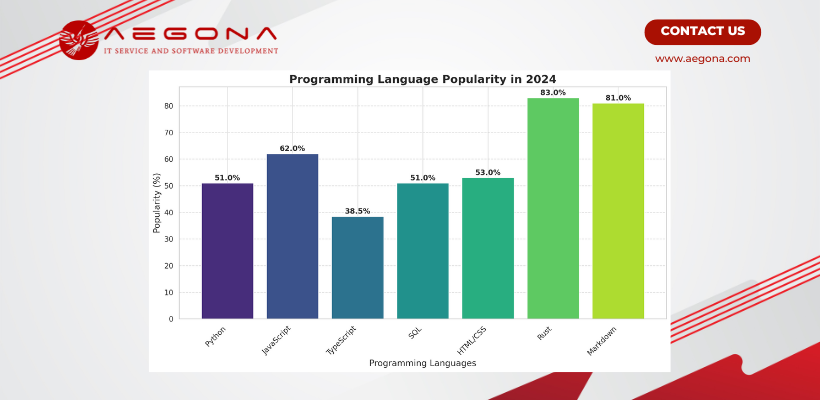Programming Trends 2025: Insights and Predictions
Python
- Python remained the leader in programming, thanks to its simplicity and powerful libraries. It’s the go-to language for AI, machine learning, and data science projects.
JavaScript/TypeScript
- JavaScript, alongside its superset TypeScript, continued to dominate both frontend and backend development. Frameworks like React, Angular, and Next.js kept these languages in high demand.
Rust
- Rust’s focus on memory safety and performance made it a favorite for system-level programming and projects requiring scalability.
Go (Golang)
- Google’s Go language became the preferred choice for cloud-native applications and microservices due to its efficiency and simplicity.
Kotlin
- Kotlin strengthened its position as the preferred language for Android development, offering robust support and seamless compatibility with Java.
Swift
- Apple’s Swift remained essential for iOS app development, thanks to its modern syntax and improved performance features.
Ruby
- Ruby, driven by the Rails framework, saw renewed interest among developers for its productivity in web development.
Julia and R
- Niche but powerful, Julia and R gained traction in the AI and data science communities for specialized applications.
Programming Language Popularity in 2024
Based on data from the GitHub Octoverse 2024 and Stack Overflow Developer Survey 2024, here are the most popular programming languages this year:
- Python: 51% popularity, thriving in AI and data science.
- JavaScript: 62%, leading web development.
- TypeScript: 38.5%, favored for scalable frontend projects.
- Rust: 83%, the most admired language for performance and safety.
For detailed insights, check GitHub Octoverse and Stack Overflow Survey. The chart above illustrates the trends visually.

Programming Trends in 2024
>> Learn more: How 6G Transforms Mobile App Development?
- AI-Driven Development: Python and Julia saw exponential growth due to advancements in artificial intelligence and machine learning.
- Cloud-Native Technologies: Languages like Go and Rust thrived as businesses moved towards scalable cloud solutions.
- Web Assembly (Wasm): A growing number of developers embraced Wasm for high-performance web applications.
- Cross-Platform Development: Dart (via Flutter) and React Native became essential for building apps that work across platforms.
Predictions for 2025
Looking ahead, 2025 is set to be a transformative year for programming. Here are the key trends to watch:
>> learn more: Staff Augmentation vs Outsourcing: What Works Best for Your Business Strategy?
>> learn more: DeepSeek AI: The AI Assistant & Applications for Business
- AI and Automation
- Expect Python, Julia, and R to lead as AI technologies expand. AI-specific tools and languages may emerge to meet growing demand.
- Green Coding Practices
- With sustainability becoming a priority, developers will lean towards energy-efficient languages like Rust and Go.
- Quantum Computing
- Quantum-specific languages like Q# will gain traction as quantum technologies advance.
- Low-Code and No-Code Platforms
- These platforms will grow in popularity, pushing script-friendly languages like JavaScript to the forefront.
- Enhanced Web Development
- TypeScript and Web Assembly will continue to dominate as businesses demand faster, more responsive web applications.


Comments
Post a Comment